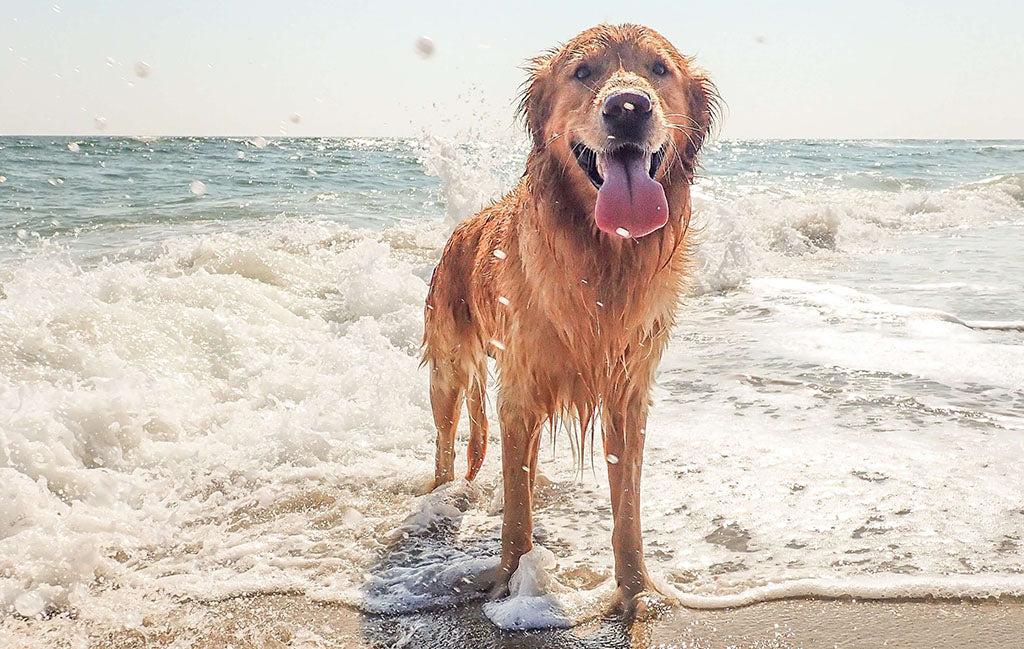Is your dog straining to poop? Seeing your dog in discomfort when trying to defecate can be distressing, and it’s natural for loving pet owners to wonder what they can do to help. Here, we’ll explore the most common reasons why your dog may be straining to poop, what signs to watch out for, how to support your dog at home, and when to seek veterinary care.
What Does It Mean When Your Dog Is Straining to Poop?
While constipation is a common reason that dogs strain when pooping, straining can also point to other issues like diarrhea, anal gland problems, inflammation, or even intestinal obstruction.
Most healthy dogs defecate at least once a day. You’ll typically see them assume a squatting position, often circling or sniffing beforehand to find the right spot. While there will be some brief abdominal muscle tensing or pushing, the act of passing the feces should be relatively quick and easy.
Straining to defecate is medically known as tenesmus, and it is a symptom that can be caused by many different conditions. If your dog is straining to defecate, you may notice the following:
- Frequently posturing to defecate while producing little to no feces
- Excessive effort – pushing, tensing the abdomen, holding the position for a long time
- Discomfort – abdominal pain, whining, licking, chewing, scooting, circling, restlessness
- Symptoms associated with the underlying condition, such as vomiting, loss of appetite, weight loss, lethargy, bloody stool, or diarrhea
When a dog strains to defecate, the appearance of the feces, if any is produced, can offer important clues about the underlying issue. Straining to defecate often indicates constipation, which is characterized by small, hard feces. Thin or ribbon-like stool might suggest a partial blockage or narrowing of the colon, such as from an enlarged prostate gland or a mass. Dogs with colitis (colon inflammation) often pass small amounts of diarrhea that may contain mucus or bright red blood.
To help standardize descriptions of fecal consistency, veterinarians often use a Stool Form Scale, which classifies stools into seven types based on shape and texture. Using this scale and accompanying pictures helps owners communicate effectively with their vet and aids in assessing bowel function and health.

Here Are 8 Common Reasons Your Dog May Be Straining To Poop
Constipation Is One of the Most Common Reasons Why Dogs Strain To Poop
In addition to straining, constipated dogs may have infrequent bowel movements, and the feces that are produced will typically be small, dry, and hard (although, in some cases, a small amount of liquid feces may pass). Constipation can be a result of an underlying medical condition, diet, or lifestyle. While minor cases may be managed at home, constipation is very painful and can progress to a serious condition known as obstipation if not promptly treated. Common causes of constipation include:
- Dehydration
- Lack of fiber in the diet
- Low-quality diet
- Lack of exercise
- Medication side effects
- Ingestion of foreign material
- Endocrine disease, such as hypothyroidism
- Megacolon
- Stress or anxiety
Diarrhea Can Cause Several of the Same Symptoms as Constipation in Dogs
If your dog is straining to poop but is not constipated, they may be having diarrhea. Surprisingly, diarrhea can cause several of the same symptoms as constipation, including straining to defecate and an increased urge to go. Dogs with diarrhea will have soft or liquid stools, which may contain blood or mucus. There are many conditions that can cause diarrhea in dogs, ranging from mild and often self-limiting (such as stress or dietary indiscretion) to severe (such as pancreatitis, inflammatory bowel disease, or cancer). Diarrhea may or may not be accompanied by other signs of gastrointestinal upset, such as vomiting, decreased appetite, and weight loss in chronic cases.
An Intestinal or Rectal Blockage Can Cause Your Dog To Strain When Pooping
An intestinal obstruction is one of the most concerning possible reasons why a dog is straining to poop, and will often be accompanied by other symptoms such as vomiting, lethargy, and abdominal pain. Blockages are most often caused by the ingestion of foreign objects (like bones, toys, or rocks). They can also be associated with tumors within the bowel wall or external pressure (from an enlarged prostate gland or other abdominal masses). Feces will continue to build up in front of the obstruction, which can cause dogs to strain in an attempt to defecate. In some cases, small amounts of liquid feces may make it past. This condition can be life-threatening and requires emergency surgery.
Proctitis or Colitis (Inflammation) Is a Common Reason Why Dogs Strain To Poop
Inflammation of the colon (colitis) or rectum (proctitis) is a common cause of soft stool (often containing blood or mucus), urgency, and straining to defecate. Common underlying causes include dietary indiscretion, food allergies or intolerances, infections, parasites, stress, or underlying conditions like inflammatory bowel disease (IBD).
Rectal or Perianal Tumors Can Lead To Straining During Defecation
Growths or tumors within the rectum or perianal region (around the anus) can lead to straining if they physically interfere with the passage of stool or cause discomfort during defecation. Growths can be malignant or benign, so it’s important to see your vet for an exam and biopsy. Owners might also notice blood in the stool, excessive licking of the area, or a visible lump.
Parasites Can Cause Gastrointestinal Symptoms in Dogs, Like Scooting and Straining
There are several types of intestinal parasites, such as hookworms, whipworms, and roundworms, that can cause gastrointestinal symptoms. While diarrhea is a common symptom, parasites can also cause irritation, leading to tenesmus and scooting. Worms may or may not be visible in the feces. Checking a fecal sample yearly and keeping up to date on a broad-spectrum flea, heartworm, and parasite preventative is the best way to help protect your dog.
Anal Gland Issues Can Cause Your Dog To Be Reluctant To Defecate, or Strain To Do So
The anal glands are small sacs on each side of the anus that contain a fishy smelling material. If the anal glands become impacted, infected, or abscessed, it can be extremely painful. Dogs may be reluctant to defecate, cry out when attempting to go, or strain. Other common signs include scooting their rear end on the floor, excessive licking or chewing, swelling beside the anus, foul odor, or leaking of blood or pus. Anal gland issues can occur in any dog, but are most common in smaller breeds or dogs with chronic soft stool.
Injury or Pain Around the Rear Can Cause a Dog To Be Unable To Defecate Normally
Pain originating from the structures around the rear end can make a dog reluctant or unable to defecate normally, often resulting in secondary constipation. This can include pain from injuries like bite wounds, trauma to the tail base or pelvis, neurological damage, or skin irritation/infection around the anus. Orthopedic pain (such as hip dysplasia or arthritis) can make the act of squatting and pushing painful, leading to dyschezia (painful defecation) and straining.
Can a Dog Bleed from Straining to Poop?
Blood in the feces could be a result of irritation or small tears caused by straining to pass hard stool, or associated with the underlying issue that has led to straining in the first place. Typically, blood seen when a dog is straining is bright red (hematochezia), which indicates that bleeding is occurring in the lower part of the digestive system, such as the colon, rectum, or anus. It might appear as streaks on the surface of hard stool (often associated with constipation, rectal masses, or anal gland issues) or appear mixed in with soft or liquid stool (as in the case of colitis). It’s important to differentiate the presence of bright red blood from melena, which is digested blood that appears dark, black, and tarry.
If your dog is straining to poop blood, this is not normal. Anytime you observe blood in your dog’s feces, especially if accompanied by other symptoms, it is important to consult your veterinarian as soon as possible.
What to Do If Your Dog Is Straining to Poop
If you notice that your dog is straining to poop, the first step is to determine if and when veterinary care is needed. While in some cases straining to defecate may resolve with home care, it often indicates an underlying issue requiring veterinary treatment.
When To See the Vet About Your Dog’s Difficulty Defecating
Persistent or severe straining requires immediate veterinary attention. In some cases, your dog straining to defecate can be considered a medical emergency (such as an intestinal obstruction). In other cases, veterinary diagnostics and treatments are needed to determine and manage the underlying cause, whether it’s severe constipation, inflammation, pain, or another condition.
Seek veterinary care if your dog is straining to poop, and:
- Your dog has not passed feces for 2-3 days
- Your dog is in pain or distress
- Straining to defecate is accompanied by other signs of illness, such as vomiting, loss of appetite, lethargy, weight loss, or hematochezia (bloody stool)
- Straining is persistent or worsening
Your vet will begin by gathering a detailed medical history and performing a nose-to-tail physical exam, including a rectal exam. They may then recommend further testing, such as fecal tests to check for parasites, bloodwork to evaluate overall health and organ function, and imaging like X-rays or ultrasound to help visualize potential constipation, obstructions, tumors, orthopedic issues, or other abnormalities.
Treatment will depend on the underlying cause but may include fluid therapy, enemas or manual removal of impacted feces, stool softeners, dietary changes, antibiotics, pain medication, and even surgery in some cases.
Ways You Can Help at Home if Your Dog Is Straining To Poop
If your dog appears otherwise normal (in terms of their appetite, energy level, urination, and behaviors) and is still able to pass stool, you may try the following steps at home while continuing to monitor.
- Increase hydration: Make sure that fresh water is easily accessible at all times. To increase hydration, you may offer your dog canned food or moisten their kibble with water or low-sodium chicken broth.
- Provide gentle exercise: Regular, gentle movement, such as short walks, can help stimulate digestion and get things moving. Avoid intense or strenuous activity, especially if your dog seems uncomfortable.
- Add fiber to the diet: For mild constipation, adding a small amount of appropriate fiber can help bulk up the stool and draw water into it, making it easier to pass. If your dog is straining to poop but has diarrhea, fiber may also help. Plain canned pumpkin puree (NOT pumpkin pie filling) is a popular option to start with. Mix a small amount into your dog’s meals (approximately one teaspoon for small dogs and one tablespoon for large dogs). Ensure your dog is well-hydrated when adding fiber, as fiber without enough water can worsen constipation. It’s always best to consult your vet before making significant dietary changes.
- Add probiotics to the diet: These beneficial bacteria can help manage diarrhea and improve overall gut health.
- Keep a stool diary or take a sample to your vet if possible: Keep a close eye on your dog’s attempts to defecate and the consistency, volume, and appearance of any stool produced. If you seek veterinary care, ask if you should bring a fresh fecal sample.
My Dog Is Straining To Poop: Conclusion
Straining to defecate is a common symptom with many possible causes, ranging from constipation or diarrhea to more complex issues, like intestinal blockages or tumors. Because the appropriate treatment depends entirely on the correct diagnosis, it’s important for pet parents to observe their dog’s symptoms closely, such as the frequency and severity of straining, the appearance (or lack) of any feces produced, and any accompanying signs. Seek veterinary attention promptly if your dog seems distressed, hasn’t pooped in over 48 hours, or shows other signs of illness. Although seeing your dog strain to poop is concerning, most cases and be effectively managed with appropriate veterinary care.






